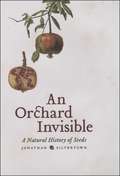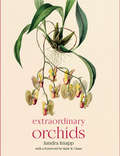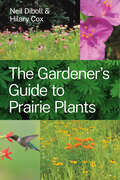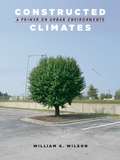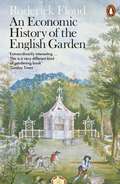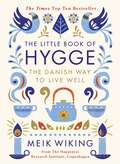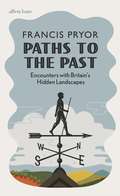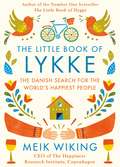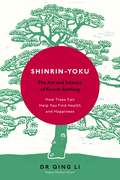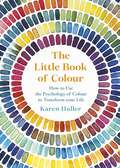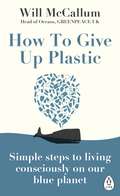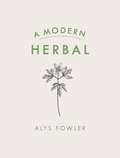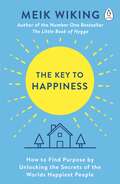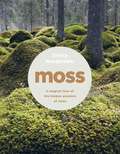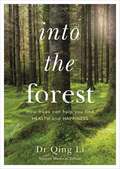- Table View
- List View
An Orchard Invisible: A Natural History of Seeds
by Jonathan SilvertownThe story of seeds, in a nutshell, is a tale of evolution. From the tiny sesame that we sprinkle on our bagels to the forty-five-pound double coconut borne by the coco de mer tree, seeds are a perpetual reminder of the complexity and diversity of life on earth. With An Orchard Invisible, Jonathan Silvertown presents the oft-ignored seed with the natural history it deserves, one nearly as varied and surprising as the earth’s flora itself. Beginning with the evolution of the first seed plant from fernlike ancestors more than 360 million years ago, Silvertown carries his tale through epochs and around the globe. In a clear and engaging style, he delves into the science of seeds: How and why do some lie dormant for years on end? How did seeds evolve? The wide variety of uses that humans have developed for seeds of all sorts also receives a fascinating look, studded with examples, including foods, oils, perfumes, and pharmaceuticals. An able guide with an eye for the unusual, Silvertown is happy to take readers on unexpected—but always interesting—tangents, from Lyme disease to human color vision to the Salem witch trials. But he never lets us forget that the driving force behind the story of seeds—its theme, even—is evolution, with its irrepressible habit of stumbling upon new solutions to the challenges of life. "I have great faith in a seed," Thoreau wrote. "Convince me that you have a seed there, and I am prepared to expect wonders." Written with a scientist’s knowledge and a gardener’s delight, An Orchard Invisible offers those wonders in a package that will be irresistible to science buffs and green thumbs alike.
An Orchard Invisible: A Natural History of Seeds
by Jonathan SilvertownThe story of seeds, in a nutshell, is a tale of evolution. From the tiny sesame that we sprinkle on our bagels to the forty-five-pound double coconut borne by the coco de mer tree, seeds are a perpetual reminder of the complexity and diversity of life on earth. With An Orchard Invisible, Jonathan Silvertown presents the oft-ignored seed with the natural history it deserves, one nearly as varied and surprising as the earth’s flora itself. Beginning with the evolution of the first seed plant from fernlike ancestors more than 360 million years ago, Silvertown carries his tale through epochs and around the globe. In a clear and engaging style, he delves into the science of seeds: How and why do some lie dormant for years on end? How did seeds evolve? The wide variety of uses that humans have developed for seeds of all sorts also receives a fascinating look, studded with examples, including foods, oils, perfumes, and pharmaceuticals. An able guide with an eye for the unusual, Silvertown is happy to take readers on unexpected—but always interesting—tangents, from Lyme disease to human color vision to the Salem witch trials. But he never lets us forget that the driving force behind the story of seeds—its theme, even—is evolution, with its irrepressible habit of stumbling upon new solutions to the challenges of life. "I have great faith in a seed," Thoreau wrote. "Convince me that you have a seed there, and I am prepared to expect wonders." Written with a scientist’s knowledge and a gardener’s delight, An Orchard Invisible offers those wonders in a package that will be irresistible to science buffs and green thumbs alike.
An Orchard Invisible: A Natural History of Seeds
by Jonathan SilvertownThe story of seeds, in a nutshell, is a tale of evolution. From the tiny sesame that we sprinkle on our bagels to the forty-five-pound double coconut borne by the coco de mer tree, seeds are a perpetual reminder of the complexity and diversity of life on earth. With An Orchard Invisible, Jonathan Silvertown presents the oft-ignored seed with the natural history it deserves, one nearly as varied and surprising as the earth’s flora itself. Beginning with the evolution of the first seed plant from fernlike ancestors more than 360 million years ago, Silvertown carries his tale through epochs and around the globe. In a clear and engaging style, he delves into the science of seeds: How and why do some lie dormant for years on end? How did seeds evolve? The wide variety of uses that humans have developed for seeds of all sorts also receives a fascinating look, studded with examples, including foods, oils, perfumes, and pharmaceuticals. An able guide with an eye for the unusual, Silvertown is happy to take readers on unexpected—but always interesting—tangents, from Lyme disease to human color vision to the Salem witch trials. But he never lets us forget that the driving force behind the story of seeds—its theme, even—is evolution, with its irrepressible habit of stumbling upon new solutions to the challenges of life. "I have great faith in a seed," Thoreau wrote. "Convince me that you have a seed there, and I am prepared to expect wonders." Written with a scientist’s knowledge and a gardener’s delight, An Orchard Invisible offers those wonders in a package that will be irresistible to science buffs and green thumbs alike.
An Orchard Invisible: A Natural History of Seeds
by Jonathan SilvertownThe story of seeds, in a nutshell, is a tale of evolution. From the tiny sesame that we sprinkle on our bagels to the forty-five-pound double coconut borne by the coco de mer tree, seeds are a perpetual reminder of the complexity and diversity of life on earth. With An Orchard Invisible, Jonathan Silvertown presents the oft-ignored seed with the natural history it deserves, one nearly as varied and surprising as the earth’s flora itself. Beginning with the evolution of the first seed plant from fernlike ancestors more than 360 million years ago, Silvertown carries his tale through epochs and around the globe. In a clear and engaging style, he delves into the science of seeds: How and why do some lie dormant for years on end? How did seeds evolve? The wide variety of uses that humans have developed for seeds of all sorts also receives a fascinating look, studded with examples, including foods, oils, perfumes, and pharmaceuticals. An able guide with an eye for the unusual, Silvertown is happy to take readers on unexpected—but always interesting—tangents, from Lyme disease to human color vision to the Salem witch trials. But he never lets us forget that the driving force behind the story of seeds—its theme, even—is evolution, with its irrepressible habit of stumbling upon new solutions to the challenges of life. "I have great faith in a seed," Thoreau wrote. "Convince me that you have a seed there, and I am prepared to expect wonders." Written with a scientist’s knowledge and a gardener’s delight, An Orchard Invisible offers those wonders in a package that will be irresistible to science buffs and green thumbs alike.
The Porch: Meditations on the Edge of Nature
by Charlie HaileyCome with us for a moment out onto the porch. Just like that, we’ve entered another world without leaving home. In this liminal space, an endless array of absorbing philosophical questions arises: What does it mean to be in a place? How does one place teach us about the world and ourselves? What do we—and the things we’ve built—mean in this world? In a time when reflections on the nature of society and individual endurance are so paramount, Charlie Hailey’s latest book is both a mental tonic and a welcome provocation. Solidly grounded in ideas, ecology, and architecture, The Porch takes us on a journey along the edges of nature where the outside comes in, hosts meet guests, and imagination runs wild. Hailey writes from a modest porch on the Homosassa River in Florida. He sleeps there, studies the tides, listens for osprey and manatee, welcomes shipwrecked visitors, watches shadows on its screens, reckons with climate change, and reflects on his own acclimation to his environment. The profound connections he unearths anchor an armchair exploration of past porches and those of the future, moving from ancient Greece to contemporary Sweden, from the White House roof to the Anthropocene home. In his ruminations, he links up with other porch dwellers including environmentalist Rachel Carson, poet Wendell Berry, writers Eudora Welty and Zora Neale Hurston, philosopher John Dewey, architect Louis Kahn, and photographer Paul Strand. As close as architecture can bring us to nature, the porch is where we can learn to contemplate anew our evolving place in a changing world—a space we need now more than ever. Timeless and timely, Hailey’s book is a dreamy yet deeply passionate meditation on the joy and gravity of sitting on the porch.
The Porch: Meditations on the Edge of Nature
by Charlie HaileyCome with us for a moment out onto the porch. Just like that, we’ve entered another world without leaving home. In this liminal space, an endless array of absorbing philosophical questions arises: What does it mean to be in a place? How does one place teach us about the world and ourselves? What do we—and the things we’ve built—mean in this world? In a time when reflections on the nature of society and individual endurance are so paramount, Charlie Hailey’s latest book is both a mental tonic and a welcome provocation. Solidly grounded in ideas, ecology, and architecture, The Porch takes us on a journey along the edges of nature where the outside comes in, hosts meet guests, and imagination runs wild. Hailey writes from a modest porch on the Homosassa River in Florida. He sleeps there, studies the tides, listens for osprey and manatee, welcomes shipwrecked visitors, watches shadows on its screens, reckons with climate change, and reflects on his own acclimation to his environment. The profound connections he unearths anchor an armchair exploration of past porches and those of the future, moving from ancient Greece to contemporary Sweden, from the White House roof to the Anthropocene home. In his ruminations, he links up with other porch dwellers including environmentalist Rachel Carson, poet Wendell Berry, writers Eudora Welty and Zora Neale Hurston, philosopher John Dewey, architect Louis Kahn, and photographer Paul Strand. As close as architecture can bring us to nature, the porch is where we can learn to contemplate anew our evolving place in a changing world—a space we need now more than ever. Timeless and timely, Hailey’s book is a dreamy yet deeply passionate meditation on the joy and gravity of sitting on the porch.
Extraordinary Orchids
by Sandra KnappPerching on tropical trees, partnering with fungi to reproduce, or deceiving birds and amorous insects to promote pollination, orchids fascinate. In the exquisitely illustrated Extraordinary Orchids, award-winning botanist and writer Sandra Knapp tells the stories behind some of the bizarre lifestyles and interactions that scientists have uncovered among many species of the orchid family. Orchids deserve such a visual celebration: parts of the orchid flower have shapes unlike any other flowering plant, and the sheer number of species means they have a seemingly endless ability to create ever more fantastical forms. In fact, many orchid common names refer to the shape-shifting forms of their flowers—the “man-orchids” or “monkey-orchids” are so called because of their resemblance to the primate form. Orchids lend themselves to depiction, and botanical artworks of them abound. Who could resist painting or drawing such odd shapes? Illustrated with stunning artwork, much from the archives of the Natural History Museum in London and never before published, Extraordinary Orchids includes depictions from celebrated botanical artists such as Ferdinand and Franz Bauer, Arthur Harry Church, and Sydney Parkinson, revealing the weird and wonderful lives of this most diverse of plant families.
The Gardener's Guide to Prairie Plants (Emersion: Emergent Village Resources For Communities Of Faith Ser.)
by Neil Diboll Hilary CoxA comprehensive and beautifully illustrated reference for all gardeners passionate about native plants and prairie restoration. The Gardener’s Guide to Prairie Plants is the one-stop compendium for all gardeners aspiring to use native prairie plants in their gardens. Neil Diboll and Hilary Cox—two renowned prairie gardeners—compile more than four decades’ worth of research to offer a wide-ranging and definitive reference for starting and maintaining prairie and meadow gardens and restorations. Alongside detailed synopses of plant life cycles, meticulous range maps, and sweeping overviews of natural history, Diboll and Cox also include photographs of 148 prairie plants in every stage of development, from seedling to seedhead. North America’s grasslands once stretched from the Blue Ridge to the Rocky Mountains, and from Texas to Manitoba, blanketing the mid-continent with ecologically important, garden-worthy, native species. This book provides all the inspiration and information necessary for eager native planters from across the country to welcome these plants back to their landscapes. The Gardener’s Guide to Prairie Plants is a must-have reference for gardeners, restorationists, and every flora fan with a passion for native plants, prairies and meadows.
The Gardener's Guide to Prairie Plants
by Neil Diboll Hilary CoxA comprehensive and beautifully illustrated reference for all gardeners passionate about native plants and prairie restoration. The Gardener’s Guide to Prairie Plants is the one-stop compendium for all gardeners aspiring to use native prairie plants in their gardens. Neil Diboll and Hilary Cox—two renowned prairie gardeners—compile more than four decades’ worth of research to offer a wide-ranging and definitive reference for starting and maintaining prairie and meadow gardens and restorations. Alongside detailed synopses of plant life cycles, meticulous range maps, and sweeping overviews of natural history, Diboll and Cox also include photographs of 148 prairie plants in every stage of development, from seedling to seedhead. North America’s grasslands once stretched from the Blue Ridge to the Rocky Mountains, and from Texas to Manitoba, blanketing the mid-continent with ecologically important, garden-worthy, native species. This book provides all the inspiration and information necessary for eager native planters from across the country to welcome these plants back to their landscapes. The Gardener’s Guide to Prairie Plants is a must-have reference for gardeners, restorationists, and every flora fan with a passion for native plants, prairies and meadows.
In the Name of Plants: From Attenborough to Washington, the People behind Plant Names
by Sandra KnappA vividly illustrated meeting with thirty plants and their inspiring namesakes Shakespeare famously asserted that “a rose by any other name would smell as sweet,” and that’s as true for common garden roses as it is for the Megacorax, a genus of evening primroses. Though it may not sound like it, the Megacorax was actually christened in honor of famed American botanist Peter Raven, its name a play on the Latin words for “great raven.” In this lush and lively book, celebrated botanist Sandra Knapp explores the people whose names have been immortalized in plant genera, presenting little-known stories about both the featured plants and their eponyms alongside photographs and botanical drawings from the collections of London’s Natural History Museum. Readers will see familiar plants in a new light after learning the tales of heroism, inspiration, and notoriety that led to their naming. Take, for example, nineteenth-century American botanist Alice Eastwood, after whom the yellow aster—Eastwoodia elegans—is named. Eastwood was a pioneering plant collector who also singlehandedly saved irreplaceable specimens from the California Academy of Sciences during the 1906 San Francisco earthquake. Or more recently, the fern genus Gaga, named for the pop star and actress Lady Gaga, whose verdant heart-shaped ensemble at the 2010 Grammy Awards bore a striking resemblance to a giant fern gametophyte. Knapp’s subjects range from Charles Darwin’s grandfather, Erasmus Darwin (Darwinia), and legendary French botanist Pierre Magnol—who lends his name to the magnolia tree—to US founding figures like George Washington (Washingtonia) and Benjamin Franklin (Franklinia). Including granular details on the taxonomy and habitats for thirty plants alongside its vibrant illustrations, this book is sure to entertain and enlighten any plant fan.
The Greater Perfection: The Story of the Gardens at Les Quatre Vents
by Francis H. CabotThe Greater Perfection, now with a new foreword by Francis H. Cabot’s daughter, tells the story behind the creation of Les Quatre Vents, one of the world’s most breathtaking gardens. Featured in the 2018 film The Gardener, Les Quatre Vents in Charlevoix County, Quebec, has been acclaimed as the most aesthetically satisfying and horticulturally exciting landscape experience in North America. This twenty-acre garden seamlessly combines traditional and novel elements into a splendid composition, adorned with unexpected touches and perfectly compatible with its natural surroundings. The Greater Perfection, first published in 2001, illustrates the delights, diversions, and surprises that await the garden’s visitors. Francis H. Cabot’s account of the challenges he faced in developing Les Quatre Vents reveals the fascinating process behind the creation of a world-class garden that has become a mecca for horticultural enthusiasts around the globe. Winner of the 2003 Annual Literature Award of the Council on Botanical and Horticultural Libraries and featuring stunning full-color images by five leading garden photographers, The Greater Perfection is one of the most beautiful books on gardens to appear in years. This new printing includes a foreword by Marianne Cabot Welch, Cabot’s daughter, that further contextualizes the gardens and explores how a place rooted in the past can confront the future.
Constructed Climates: A Primer on Urban Environments
by William G. WilsonAs our world becomes increasingly urbanized, an understanding of the context, mechanisms, and consequences of city and suburban environments becomes more critical. Without a sense of what open spaces such as parks and gardens contribute, it’s difficult to argue for their creation and maintenance: in the face of schools needing resources, roads and sewers needing maintenance, and people suffering at the hands of others, why should cities and counties spend scarce dollars planting trees and preserving parks? In Constructed Climates, ecologist William G. Wilson demonstrates the value of urban green. Focusing specifically on the role of vegetation and trees, Wilson shows the costs and benefits reaped from urban open spaces, from cooler temperatures to better quality ground water—and why it all matters. While Constructed Climates is a work of science, it does not ignore the social component. Wilson looks at low-income areas that have poor vegetation, and shows how enhancing these areas through the planting of community gardens and trees can alleviate social ills. This book will be essential reading for environmentalists and anyone making decisions for the nature and well-being of our cities and citizens.
Constructed Climates: A Primer on Urban Environments
by William G. WilsonAs our world becomes increasingly urbanized, an understanding of the context, mechanisms, and consequences of city and suburban environments becomes more critical. Without a sense of what open spaces such as parks and gardens contribute, it’s difficult to argue for their creation and maintenance: in the face of schools needing resources, roads and sewers needing maintenance, and people suffering at the hands of others, why should cities and counties spend scarce dollars planting trees and preserving parks? In Constructed Climates, ecologist William G. Wilson demonstrates the value of urban green. Focusing specifically on the role of vegetation and trees, Wilson shows the costs and benefits reaped from urban open spaces, from cooler temperatures to better quality ground water—and why it all matters. While Constructed Climates is a work of science, it does not ignore the social component. Wilson looks at low-income areas that have poor vegetation, and shows how enhancing these areas through the planting of community gardens and trees can alleviate social ills. This book will be essential reading for environmentalists and anyone making decisions for the nature and well-being of our cities and citizens.
Constructed Climates: A Primer on Urban Environments
by William G. WilsonAs our world becomes increasingly urbanized, an understanding of the context, mechanisms, and consequences of city and suburban environments becomes more critical. Without a sense of what open spaces such as parks and gardens contribute, it’s difficult to argue for their creation and maintenance: in the face of schools needing resources, roads and sewers needing maintenance, and people suffering at the hands of others, why should cities and counties spend scarce dollars planting trees and preserving parks? In Constructed Climates, ecologist William G. Wilson demonstrates the value of urban green. Focusing specifically on the role of vegetation and trees, Wilson shows the costs and benefits reaped from urban open spaces, from cooler temperatures to better quality ground water—and why it all matters. While Constructed Climates is a work of science, it does not ignore the social component. Wilson looks at low-income areas that have poor vegetation, and shows how enhancing these areas through the planting of community gardens and trees can alleviate social ills. This book will be essential reading for environmentalists and anyone making decisions for the nature and well-being of our cities and citizens.
An Economic History of the English Garden
by Roderick FloudAt least since the seventeenth century, most of the English population have been unable to stop making, improving and dreaming of gardens. Yet in all the thousands of books about them, this is the first to address seriously the question of how much gardens and gardening have cost, and to work out the place of gardens in the economic, as well as the horticultural, life of the nation. It is a new kind of gardening history.Beginning with the Restoration of Charles II in 1660, Roderick Floud describes the role of the monarchy and central and local government in creating gardens, as well as that of the (generally aristocratic or plutocratic) builders of the great gardens of Stuart, Georgian and Victorian England. He considers the designers of these gardens as both artists and businessmen - often earning enormous sums by modern standards, matched by the nurserymen and plant collectors who supplied their plants. He uncovers the lives and rewards of working gardeners, the domestic gardens that came with the growth of suburbs and the impact of gardening on technical developments from man-made lakes to central heating.AN ECONOMIC HISTORY OF THE ENGLISH GARDEN shows the extraordinary commitment of money as well as time that the English have made to gardens and gardening over three and a half centuries. It reveals the connections of our gardens to the re-establishment of the English monarchy, the national debt, transport during the Industrial Revolution, the new industries of steam, glass and iron, and the built environment that is now all around us. It is a fresh perspective on the history of England and will open the eyes of gardeners - and garden visitors - to an unexpected dimension of what they do.
The Little Book of Hygge: The Danish Way to Live Well
by Meik WikingDenmark is often said to be the happiest country in the world. That's down to one thing: hygge.'Hygge has been translated as everything from the art of creating intimacy to cosiness of the soul to taking pleasure from the presence of soothing things. My personal favourite is cocoa by candlelight...'You know hygge when you feel it. It is when you are cuddled up on a sofa with a loved one, or sharing comfort food with your closest friends. It is those crisp blue mornings when the light through your window is just right.Who better than Meik Wiking to be your guide to all things hygge? Meik is CEO of the Happiness Research Institute in Copenhagen and has spent years studying the magic of Danish life. In this beautiful, inspiring book he will help you be more hygge: from picking the right lighting and planning a dinner party through to creating an emergency hygge kit and even how to dress.Meik Wiking is the CEO of the Happiness Research Institute in Copenhagen. He is committed to finding out what makes people happy and has concluded that hygge is the magic ingredient that makes Danes the happiest nation in the world.
Paths to the Past: Encounters with Britain's Hidden Landscapes
by Francis PryorDiscover the hidden corners and forgotten crevices of Britain's landscapes, from lost rural treasures to unseen urban gems.Landscapes reflect and shape our behaviour. They make us who we are and bear witness to the shifting patterns of human life over the generations. Bringing to bear a lifetime's digging, archaeologist Francis Pryor delves into Britain's hidden urban and rural landscapes, from Whitby Abbey to the navvy camp at Risehill in Cumbria, from Tintagel to Tottenham's Broadwater Farm. Through fields, woods, moors, roads, tracks and towns, he reveals the stories of our physical surroundings and what they meant to the people who formed them, used them and lived in them. These landscapes, he stresses, are our common physical inheritance. If we can understand how to make them yield up their secrets, it will help us, their guardians, to maintain and shape them for future generations.
The Little Book of Lykke: The Danish Search for the World's Happiest People
by Meik WikingLykke (Luu-kah) (n): Happiness It's easy to see why Denmark is often called the world's happiest country. Not only do they have equal parental leave for men and women, free higher education and trains that run on time, but they burn more candles per household than anywhere else.So nobody knows more about happiness - what the Danes call lykke - than Meik Wiking, CEO of the Happiness Research Institute in Copenhagen and author of the bestselling sensation The Little Book of Hygge. But he believes that, whilst we can certainly learn a lot from the Danes about finding fulfilment, the keys to happiness are actually buried all around the globe.In this captivating book, he takes us on a treasure hunt to unlock the doors to inner fulfilment. From how we spend our precious time, to how we relate to our neighbours and cook dinner, he gathers evidence, stories and tips from the very happiest corners of the planet. This is the ultimate guide to how we can all find a little more lykke in our lives.
Shinrin-Yoku: The Art and Science of Forest Bathing
by Dr Qing LiShinrin = Forest Yoku = Bathing Shinrin-Yoku or forest bathing is the practice of spending time in the forest for better health, happiness and a sense of calm. A pillar of Japanese culture for decades, Shinrin-Yoku is a way to reconnect with nature, from walking mindfully in the woods, to a break in your local park, to walking barefoot on your lawn. Forest Medicine expert, Dr Qing Li's research has proven that spending time around trees (even filling your home with house plants and vaporising essential tree oils) can reduce blood pressure, lower stress, boost energy, boost immune system and even help you to lose weight. Along with his years of ground-breaking research, anecdotes on the life-changing power of trees, Dr Li provides here the practical ways for you to try Shinrin-Yoku for yourself.
The Little Book of Colour: How to Use the Psychology of Colour to Transform Your Life
by Karen HallerThe definitive guide for harnessing the power of colour to improve your happiness, wellbeing and confidenceWouldn't you like to boost your confidence simply by slipping on 'that' yellow jumper? Or when you get home after a stressful day, be instantly soothed by the restful green of your walls?The colours all around us hold an emotional energy. Applied Colour Psychology specialist, Karen Haller, explains the inherent power of colour; for example, looking closely at the colours we love or those we dislike can bring up deeply buried memories and with them powerful feelings. A revolutionary guide to boosting your wellbeing, The Little Book of Colour puts you firmly in the driver's seat and on the road to changing the colours in your world to revamp your mood and motivation. Illuminating the science, psychology and emotional significance of colour, with key assessments for finding your own true colour compatibility, this book will help you to rediscover meaning in everything you do through the joy of colour.Get ready to join the colour revolution, and change your life for the better.
How to Give Up Plastic: A Guide to Changing the World, One Plastic Bottle at a Time. From the Head of Oceans at Greenpeace and spokesperson for their anti-plastic campaign
by Will McCallum'We have a responsibility, every one of us' David Attenborough Around 12.7 million tonnes of plastic are entering the ocean every year, killing over 1 million seabirds and 100,000 marine mammals.By 2050 there could be more plastic in the ocean than fish by weight.Plastic pollution is the environmental scourge of our age, but how can YOU make a difference? This accessible guide, written by the campaigner at the forefront of the anti-plastic movement, will help you make the small changes that make a big difference, from buying a reusable coffee cup to running a clean-up at your local park or beach. Tips on giving up plastic include:· Washing your clothes within a wash bag to catch plastic microfibers (the cause of 30% of plastic pollution in the ocean)· Replacing your regular shampoo with bar shampoo· How to lobby your supermarket to remove unnecessary packaging · How to throw a plastic-free birthday party· How to convince others to join you in giving up plasticPlastic is not going away without a fight. We need a movement made up of billions of individual acts, bringing people together from all backgrounds and all cultures, the ripples of which will be felt from the smallest village to the tallest skyscrapers. This is a call to arms - to join forces across the world and to end our dependence on plastic. #BreakFreeFromPlasticPlastic is not going away without a fight. We need a movement made up of billions of individual acts, bringing people together from all backgrounds and all cultures, the ripples of which will be felt from the smallest village to the tallest skyscrapers.'Plastic waste is one of the greatest environmental challenges facing the world' Theresa May
A Modern Herbal
by Alys FowlerPlant-based medicine for a calmer, healthier life It's easy to turn to the pharmacy when we're stressed, sick or feeling under the weather, but what if you turned to your garden instead?In this accessible and easy to use manual, horticultural expert, former Gardener's World presenter and Guardiancolumnist, Alys Fowler, shows how to take control of your health by adopting a more natural lifestyle. For thousands of years, people who had no access to clinical medicine knew how to boost their well-being by using the ingredients they found in plants. Herbs are the people's medicine; often freely available and abundant, they are ready and waiting to be plucked from around you to soothe and heal your body and mind. With guides for how to use and grow over 100 herbs - for example how to use fennel for indigestion, camomile for anxiety and nettle for hayfever - you'll soon be heading into the garden, rather than opening the medicine cabinet. Offering a fusion of botanical, practical, cultural and historical information, A Modern Herbal reveals how common herbs are the simple, cleansing way to better health and happiness.AS SEEN IN THE GUARDIAN
The Key to Happiness: How to Find Purpose by Unlocking the Secrets of the World's Happiest People
by Meik Wiking** FROM THE INTERNATIONALLY BESTSELLING AUTHOR ****Previously published as The Little Book of Lykke**"A wonderful guide to happy living. It's based on hard evidence and written with a wonderful sense of fun" Richard Layard, Centre for Economic Performance, LSE and author of HappinessHappiness is just around the corner with this practical guide from happiness researcher Meik WikingMeik Wiking understands happiness better than anyone. In his role as Founder and CEO of the world's only Happiness Research Institute, he has travelled the globe interviewing the world's happiest people to discover the key components of happiness.In The Key to Happiness, Meik explores the hidden treasures which can improve your happiness, and divides them into the six building blocks of happiness; togetherness, money, health, kindness, trust and freedom. For each happiness block he offers practical tips: for togetherness he encourages setting up a mini-library in your apartment building or starting a tool-sharing programme in your street; for kindness he suggests leaving a surprise gift on a stranger's doorstep, helping a tourist find their way or telling someone who means a lot to you that they do.Drawing on social science, case studies and Meik's original research, this practical guide shows us that you can find happiness in a simple way of life. While Meik has travelled across the glove to discover the secrets of the world's happiest people, this book shows us that you can be just as happy where you are.This book is the perfect guide on how to survive and navigate the modern world with a smile on your face."An inspiring and highly engaging exploration of what really makes us happy, all underpinned by the latest research" Dr Mark Williamson Director of Action for Happiness
Moss
by Ulrica NordströmExplore the magical world of moss, with this fully-illustrated and comprehensive guide. Moss is all around us. While it is most often associated with damp, shady spaces, it can be found in the most unexpected and far-flung places, from deserts to Antarctica. This book is a celebration of its quiet, unassuming beauty and a primer to understanding the secrets of the world's most ancient plant: · Discover the fascinating history of this soft and tactile plant · Learn how and where to identify and gather different moss species.· Take a tour of some of the most beautiful moss gardens in the UK, the US and Japan, where moss viewing has become a national phenomenon.· Learn how to cultivate moss, tie Japanese moss balls (kokedama) and plant moss landscapes in pots and terrariums.With stunning photography and botanical illustration, this is an utterly unique book that will be treasured by plant enthusiasts of all kinds.
Into the Forest: How Trees Can Help You Find Health and Happiness
by Dr Qing LiHumans are increasingly becoming an indoor species. We spend 90 per cent of our life indoors. And, on average, we dedicate eight hours a day looking at screens. Our increasingly domestic lives are having huge consequences to our health. In Into the Forest, Immunologist and Forest Medicine expert, Dr Qing Li, examines the unprecedented benefits of the world's largest natural health resource: the great outdoors.Applying cutting-edge research and emerging science, Dr Li explores the inherent connection between nature and improved wellbeing. This practical guide will help you overcome some of life's most problematic health issues, including how to: · reduce blood pressure; · lower stress;· improve energy levels;· and boost the immune system. From mindful strolls in your local park to listening to the wind, from watching the sunset to walking barefoot in the grass, Dr Li reveals the life-improving advantages of spending time around trees, for a healthier and happier you.
